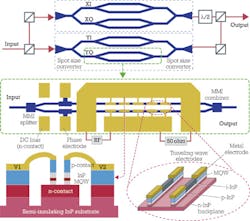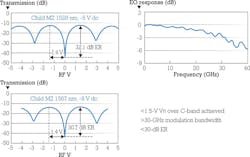Optical IQ modulators for coherent 100G and beyond
Indium phosphide can overcome the limitations of LiNbO3, opening the door to the performance tomorrow's coherent transmission systems will require.
By GARY WANG
The continued increase in fiber capacity demand is driving advances in coherent optical-communication systems. First generation 100G coherent systems have been deployed in major central offices for a few years now. However, the need to address bandwidth requirements, port density, and system power consumption continue to influence development of technology for 200G, 400G, and beyond.
The In-Phase Quadrature-Phase (IQ) optical modulator is a critical platform used in transmitter architectures designed to address these problems. We'll explore modulator requirements for next generation coherent communication and discuss system impacts related to key modulator parameters. In particular, the benefits of indium phosphide (InP) modulator technology for these requirements will be clarified. Recent InP modulator innovations that enable low drive voltage and high bandwidth performance will be presented.
Limits of lithium niobate
The development of electro-optic Mach-Zehnder (MZ) modulators using the linear electro-optic effects of lithium niobate (LiNbO3) crystals was critical for the early advance of optical-fiber networks. While transmitter designs using directly modulated high speed laser or electro-absorption modulator (EAM) technologies may offer advantages in size and cost, their low extinction ratio (ER) always limited performance. In contrast, high amplitude ER can be achieved easily with an MZ modulator design. Efficient high speed conversion of electrical signals to modulated light using an external LiNbO3 MZ modulator has enabled ultra long haul optical-fiber links.
Although LiNbO3 IQ modulators are widely used in today's 100G deployments, there are still significant technology limitations for next gen coherent systems. As the port density and data rate of coherent systems increase, optical components must shrink while offering improved performance. A 100G CFP digital coherent optics (DCO) module will require modulators with a smaller form factor than the existing Optical Internetworking Forum (OIF) standard based on LiNbO3. A new modulator standard with a smaller form factor based on InP is presently being defined by the OIF (see Figure 1). For a CFP2 analog coherent optics (ACO) module, a compact integrated modulator and tunable-laser package may be necessary to reduce the component footprint even further.
As the cooling capacity of systems remains at the maximum limit, an increase in the component density has to be offset by a lower modulator drive voltage to reduce the total system power consumption. With the incumbent LiNbO3 technology, a lower drive voltage is difficult to achieve without an increase in the modulator length and negative impacts to other key parameters critical to next gen coherent systems.
Next gen coherent systems will thus require modulators with low drive voltage, small size, and proven reliability while keeping the insertion loss to an acceptable value. Polymer- or semiconductor-based modulator technologies might offer such small size and low drive voltage. But while research on polymer modulators has shown promising results1, the stability of the polymer material over the system's life is an important concern that limits broad deployment. Meanwhile, recent interest in silicon photonics has led to many silicon-based modulator developments.2 However, ER and insertion loss could be limiting factors for long haul systems. Although an optical amplifier can be used to overcome such insertion loss, the increased power consumption and added noise are undesirable.
InP traveling-wave MZ modulator
InP has paved the way for major advances in high speed optical-fiber communications. The ability to epitaxially tailor the material properties in III-V semiconductors has benefited tunable lasers and high speed receivers while maintaining the proven reliability of InP devices. Wafer-scale fabrication with precise process controls combined with low cost packaging has dramatically reduced the cost of components, enabling a lower cost per transmitted bit. These benefits make InP material an attractive candidate to create a modulator for next gen coherent systems.
A high speed MZ modulator that's small in size and with a low drive voltage requires a material with a large phase shift per unit length. Ternary and quaternary alloy materials grown epitaxially on InP can be bandgap engineered to alter the characteristics of the material to suit a particular device application. Using Quantum Confined Stark Effect (QCSE) in an InGaAsP alloy multiple quantum well (MQW) structure lattice matched to InP can create a substantial phase shift per unit length.3 Furthermore, modulators with a high bandwidth can be achieved with a traveling-wave electrode design, where broadband matching of the RF and optical wave group velocities can be achieved.
Figure 2 illustrates the basic device concept for a dual-polarization traveling-wave IQ modulator. Recent advances have produced commercially available InP IQ modulators with low drive voltage and high bandwidth.4 The devices are inherently small in size and ideally suited for integration with other InP-based devices such as tunable lasers and high speed receivers. This size advantage will be critical to enable compact coherent optics modules like CFP and CFP2.
Modulator requirements
The key modulator parameters for next gen coherent systems are the drive voltage required to induce a π phase shift (Vπ), linearity, ER, and modulation bandwidth.
The drive voltage directly affects the power consumption of the module or line card being integrated into the coherent system. Modulators with large drive voltages will require high power drivers, and their applications in 100G modules such as CFP and CFP2 will be limited.
CFP-DCO specifications allow 24-W maximum power dissipation for a class 3 module, while for CFP2-ACO, only 12 W is allocated for a class 2 module.5 The modulator driver power must be limited to enable applications like CFP2-ACO. Modulators with a Vπ of 1.5 V or less are highly desirable for such applications. Additionally, low-Vπ modulators enable the use of lower-voltage drivers, decreasing the complexity of the amplifier design and reducing the number of gain chips required in a package, thus leading to a potential cost benefit.
Linearity is a key requirement for 200G and 400G applications, where more advanced modulation formats will be needed. To provide a linear output, driver amplifier design requires an increased voltage supply level to compensate for the distortion at higher output voltages. A smaller modulator Vπ naturally reduces this requirement, enabling a more efficient amplifier design with a lower supply voltage.
The ER of each child and parent MZ is defined as the ratio between the maximum and minimum optical intensities measured at the same port. Poor ERs and any imbalance between the two MZ arms will induce chirp in the optical signal. Chirp is the optical phase variation due to relative variation of optical intensity.
The presence of chirp in a transmitted signal will distort the transitions between constellation points and increase the minimum required OSNR for the system. With closely spaced constellation points, higher order modulation formats such as 16QAM will require better ERs than the values defined in current 100G standards.
Although the DP-QPSK modulation format for 100G is common among system vendors, there are many approaches for future 400G systems. (This fact has led some to draw parallels to the modulation format debates that surrounded 40G about a decade ago.) Regardless, modulators with higher bandwidth will provide better linearity and spectral efficiency in such next gen coherent systems. As the Table illustrates, recent advances in InP-based traveling-wave MZ modulator have shown improved bandwidth that can lead to several system benefits.4
Application requirements of InP IQ modulators
New and improved technologies often bring different requirements to system applications. The operation of a LiNbO3 modulator is based on a linear electro-optic effect. The modulation bias point is set by a control voltage on each MZ arm, either via a bias-tee through the RF port or a separated phase electrode. InP modulator phase control is accomplished via either reverse or forward biased phase electrodes to adjust the operating points. As with all InP-based lasers or photodiodes, proper attention is required for the voltage and current limits of the control circuits.
It's well known that the strong thermal drift of LiNbO3 material requires a very fast bias control to stabilize the operation point in a system. The fast phase change can be compensated by applying a fast control signal to a phase electrode.
For InP material, this fast thermal drift is absent, leading to a lower speed, simpler control loop. For InP devices, the material characteristics still need to be stabilized using a thermo-electric cooler (TEC) to ensure constant operation over the environmental temperature range. To maintain the suppressed carrier at null bias point over the operational lifetime, a slow control loop will be needed to compensate for the device's aging.
Low-Vπ, high bandwidth InP IQ modulator
An InP modulator based on QCSE requires a DC bias to provide the necessary pn-junction electric field. To maintain a constant drive voltage across the wavelength, this DC bias needs to be adjusted across the C-band.
An example for wavelength dependence of DC bias is shown in Figure 3 using a commercially available InP IQ modulator. A 5-V DC bias is needed at 1528 nm to set the Vπ at 1.4 V, while a DC bias of 9 V is required to maintain a Vπ of 1.4 V at 1567 nm. This device also achieves >30-GHz modulation bandwidth and very high ER. The low-Vπ, high bandwidth, and ER shown here are important characteristics that will enable next gen coherent technology.
Although LiNbO3 modulators offer excellent performance for today's 100G networks, next gen large capacity coherent systems with high port density will require small-form-factor modulators with low drive voltages and high bandwidth. Intrinsic material limits bound the performance of today's LiNbO3 technology. A new modulator technology is required to satisfy future advances in coherent systems.
Combined with an advanced material engineering capability and reliable device technology, the InP platform opens new opportunities for advanced modulator developments. Low-Vπ and high bandwidth InP modulator technology is available today and will prove a key enabler for next generation high port density coherent systems that require compact modules.
References
1. Yokoyama, S.; Feng, Q.; Spring, A.; Yamamoto, K., "Electro-Optic Polymer Modulator with Low-Driving Voltage and High-Bandwidth Property Toward High-Refractive Index Waveguide Platform," IEEE Photonics Conference (IPC), 2014.
2. Dong, P.; Chongjin Xie; Buhl, L.L.; Young-Kai Chen; Sinsky, J.H.; Raybon, G., "Silicon In-Phase/Quadrature Modulator with On-Chip Optical Equalizer," ECOC 2014.
3. D.A.B. Miller, D.S. Chemla, T.C. Damen, A.C. Gossard, W. Wiegmann, T.H. Wood, C.A. Burrus, "Band-Edge Electroabsorption in Quantum Well Structures: The Quantum-Confined Stark Effect," Physical Review Letters, Vol. 53, No. 22, 1984.
4. G. Letal, K. Prosyk, R. Millett, D. Macquistan, S. Paquet, O. Thibault-Maheu, J. Gagné, P. Fortin, R. Dowlatshahi, B. Rioux, T. Thorpe, M. Hisko, R. Ma, I. Woods, "Low Loss InP C-Band IQ Modulator with 40GHz Bandwidth and 1.5V Vπ," OFC 2015.
5. CFP MSA Specifications. www.cfp-msa.org.
GARY WANG is an application engineer at TeraXion, responsible for system applications of InP modulators. He joined TeraXion in 2012 through the acquisition of Cogo Optronics. Prior to Cogo Optronics, he was the principle engineer responsible for the design and development of early 40G systems at Stratalight Communications.




